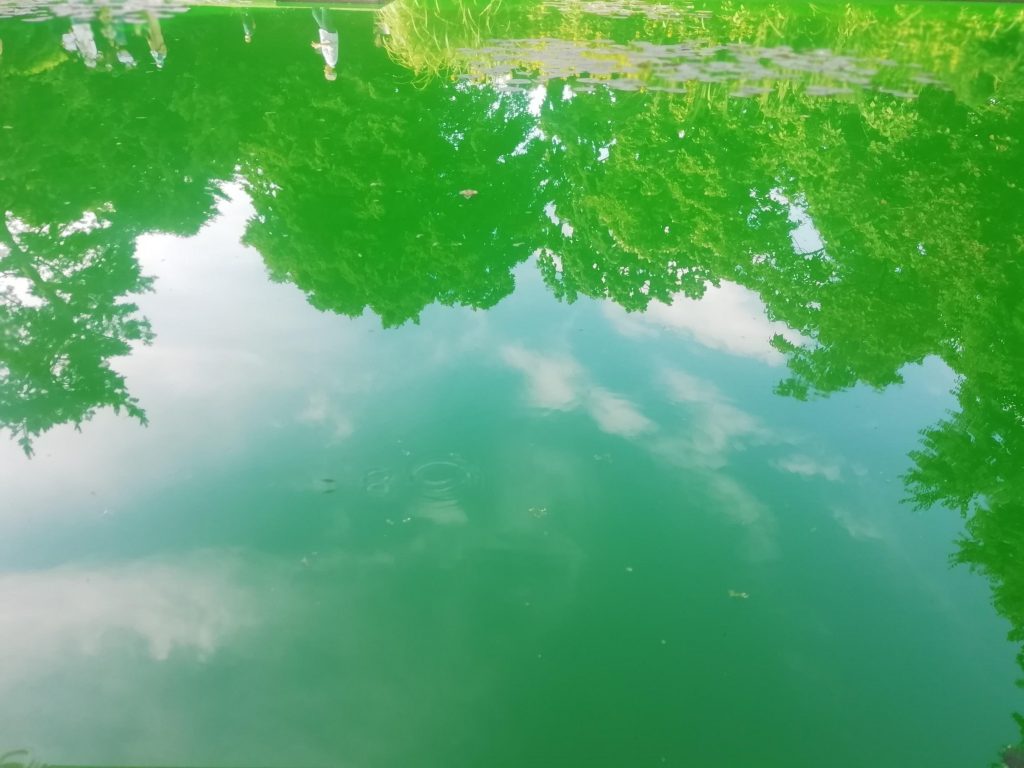
The pond of the Riehener Fondation Beyeler otherwise corresponds to Monet’s water lily pictures. It is, as it were, the connecting bridge between the museum park and the museum itself. With his current exhibition LIFE, the Berlin artist Olafur Eliasson radicalizes this connection: He colors the water a poison green, tears open the windows of the foundation, builds bridges and extends the pond deep into the exhibition rooms. What an effort for a temporary, ephemeral work of art.
A memory of an experience of my youth imposes itself on me. I grew up less than five kilometers from the location of today’s Fondation Beyeler. It was November 1, 1986, I was 15. In the “Schweizerhalle” chemical site in Basel, a warehouse belonging to the chemical company Sandoz – now Novartis – is burning brightly, the air stinks, the Rhine is colored red with discolored extinguishing water. Meanwhile I’m not sure whether we went to see it, but in any case the image of the discolored Rhine from television left an impression on me.
The poison green color of the Beyeler pond urges you to approach the water and see if there is still life there. And now my six-year-old son, whom I had with me in the exhibition, comes into play. Julius lay down on the edge of the pond and looked inside what was to be discovered besides the coloring. And he found: water snails at the edge of the pond, tadpoles in all possible stages of development (without legs, with four legs) and dragonflies. It’s amazing that the artificiality of the pond finally makes you want to take a closer look at the life in it.
And maybe the six-year-old understood the work of art better than some art experts on site. Julius ran up and down the walkways, in the museum, out again, trampled along the walkway so that his steps echoed, laughed screeching, enjoyed the thrill (no handrail on the walkway!). I want to know what would have happened if he slipped and fell into the ankle-deep pond. In any case, it wouldn’t have been as bad as a fall against a Giacometti sculpture. I think.
But you can also just sit outside in the “amphitheater” and look at the pond and the visitors. „Get caught up in the involutionary momentum that propels these beings to get entangled in one another’s lives and you will soon start to perceive affective ecologies taking shape among the thicket of relations all around you,“ explains anthropologist Natasha Myers.
Additional levels of experience result from a nightly visit, but also from a virtual, kaleidoscopic visit via livestream on Eliasson’s website: https://olafureliasson.net/life/ . With LIFE, Eliasson addresses the exhibition location as part of a work of art, and we come across the fact that one of the key protagonists in the creation of a work of art is the recipient. So: we. Eliasson explains: „With Life, I work actively to create a space of coexistence among those involved in and affected by the exhibition – the art institution, my artwork, the visitors, other beings that join in, the trees and other plants in the park, the urban landscape that surrounds the museum, and beyond. Through collectively exploring the world we share, we can, I hope, make it livable for all species.“
Go and experience it at Fondation Beyeler, Riehen, Switzerland. Learn more on https://life.fondationbeyeler.ch/en
OPENING HOURS:
Monday to Sunday 10–18
Wednesday 10–20
► Life accessible around the clock (Tickets 9 a.m.-9 p.m.)
FONDATION BEYELER
Baselstrasse 101
CH-4125 Riehen/Basel